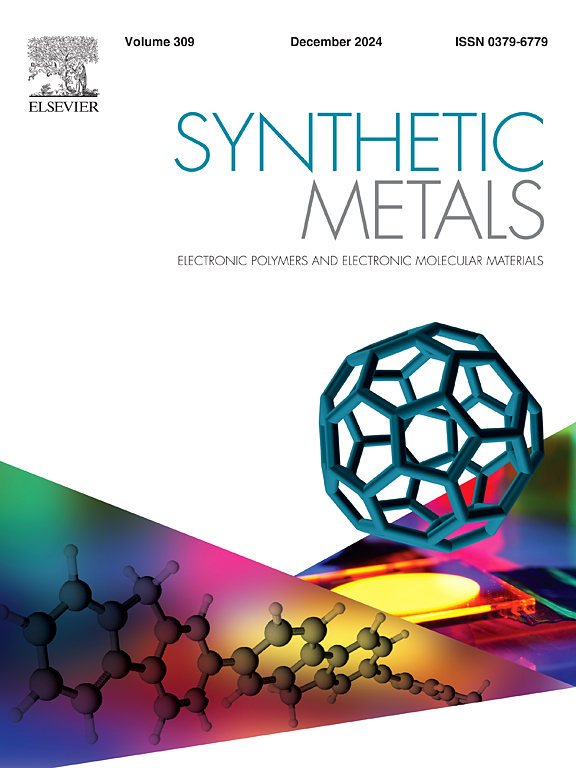Phenanthro[9,10-d]imidazole having electroactive derivatives as potential host materials for third generation organic light emitting diodes
IF 4
3区 材料科学
Q2 MATERIALS SCIENCE, MULTIDISCIPLINARY
引用次数: 0
Abstract
The new bipolar phenanthro[9,10-d]imidazole based compounds were synthesized from corresponding key starting aldehydes in reactions with phenanthrene-9,10-dione, ammonium acetate and aniline. Thermo-gravimetric analysis and differential scanning calorimetry confirmed that the new derivatives are highly thermally stable compounds and can form amorphous materials having very high glass transition temperatures exceeding 150 °C in some cases, which is big a advantage for the compounds with potential application in optoelectronic devices. Electron photoemission spectra of thin layers of the materials were used to determine ionization potentials of the materials, which are found to be in the range from 5.27 eV to 5.59 eV. LUMO energy levels of the materials were determined from their optical band gaps and values of the ionization potentials, and are in the range of 1.86–2.26 eV. Positive charge drift mobility in thin layers of some of the derivatives exceed 2.8 × 10−5 cm2V−1s−1 at high electric field at room temperature. Some of the developed materials were preliminary tested as hosts in red organic light-emitting diodes for commercial TADF based emitter: 7,10-bis(4-(diphenylamino)phenyl)-2,3-dicyanopyrazino-phenanthrene (TPA-DCPP). The results indicated that device with 9-(2-ethylhexyl)-3-(1-phenylphenanthro[9,10-d]imidazol-2-yl)carbazole exhibited good performance with rather low turn-on voltage of 3.5 V, maximum brightness of about 1000 cd/m2 and peak efficiency exceeding 5.6%. The properties are better than those of a similar device using the well-known commercial host material: 4,4′-bis(9-carbazolyl)-1,1′-biphenyl (CBP).
具有电活性衍生物的菲唑[9,10-d]咪唑作为第三代有机发光二极管的潜在宿主材料
以菲-9,10-二酮、乙酸铵和苯胺为原料,由相应的关键起始醛合成了新的双极性菲[9,10-d]咪唑基化合物。热重分析和差示扫描量热法证实,新衍生物是高度热稳定的化合物,在某些情况下可以形成玻璃化转变温度超过150 °C的非晶材料,这对具有光电器件潜在应用前景的化合物具有很大的优势。利用材料薄层的电子光电发射光谱测定了材料的电离势,电离势在5.27 eV ~ 5.59 eV之间。材料的LUMO能级由其光学带隙和电离势值确定,范围为1.86 ~ 2.26 eV。在室温高电场作用下,某些衍生物的薄层正电荷漂移率超过2.8 × 10−5 cm2V−1s−1。所开发的部分材料作为主体在商用TADF基发光材料:7,10-二(4-(二苯胺)苯基)-2,3-二氰吡嗪-菲(TPA-DCPP)的红色有机发光二极管中进行了初步测试。结果表明,含有9-(2-乙基己基)-3-(1-苯基菲壬基[9,10-d]咪唑-2-基)咔唑的器件性能良好,导通电压较低,为3.5 V,最大亮度约为1000 cd/m2,峰值效率超过5.6%。该装置的性能优于使用著名的商业主体材料:4,4 ' -双(9-咔唑基)-1,1 ' -联苯(CBP)的类似装置。
本文章由计算机程序翻译,如有差异,请以英文原文为准。
求助全文
约1分钟内获得全文
求助全文
来源期刊

Synthetic Metals
工程技术-材料科学:综合
CiteScore
8.30
自引率
4.50%
发文量
189
审稿时长
33 days
期刊介绍:
This journal is an international medium for the rapid publication of original research papers, short communications and subject reviews dealing with research on and applications of electronic polymers and electronic molecular materials including novel carbon architectures. These functional materials have the properties of metals, semiconductors or magnets and are distinguishable from elemental and alloy/binary metals, semiconductors and magnets.
 求助内容:
求助内容: 应助结果提醒方式:
应助结果提醒方式:


